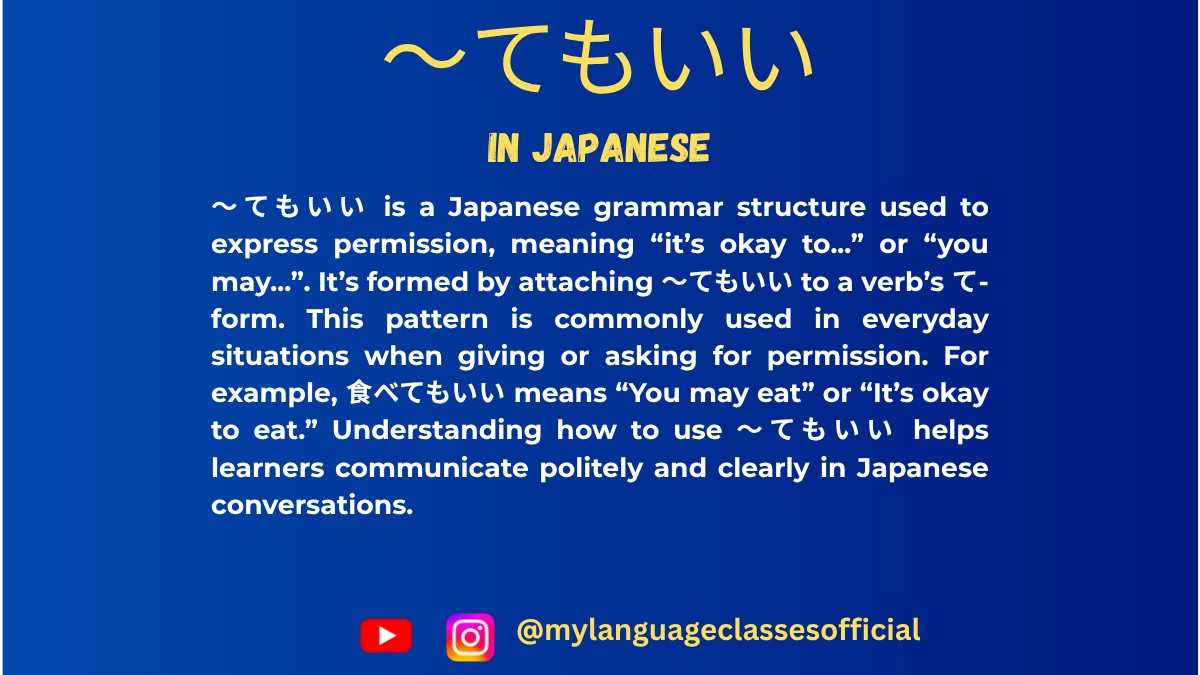Your cart is currently empty!
Tag: Japanese speaking practice
-

Understanding “〜てはいけない” in Japanese | My Language Classes
How to Use 〜てはいけない
The phrase “〜てはいけない” is a common Japanese grammatical structure used to express prohibition, or things that are not allowed. It translates to “must not” or “cannot” in English. This phrase is widely used in various contexts, from giving instructions to setting rules.
Formation of 〜てはいけない
The structure “〜てはいけない” is formed by attaching て-form of a verb to はいけない. Here’s how it works:
- Convert the verb to its て-form.
- Add はいけない to the end of the verb.
Example:
- 食べる (to eat) → 食べてはいけない (must not eat)
- 行く (to go) → 行ってはいけない (must not go)
Situations Where “〜てはいけない” is Used
- Rules and Regulations
Used to express prohibitions in formal and informal rules:- 学校で携帯電話を使ってはいけない。
(You must not use mobile phones at school.) - ここでタバコを吸ってはいけません。
(You must not smoke here.)
- 学校で携帯電話を使ってはいけない。
- Giving Orders or Instructions
Often used in scenarios where instructions need to be clear:- 試験中に話してはいけない。
(You must not talk during the exam.) - このドアを開けてはいけません。
(You must not open this door.)
- 試験中に話してはいけない。
- Moral or Ethical Prohibitions
Refers to socially unacceptable behaviors:- 他人のものを勝手に使ってはいけない。
(You must not use someone else’s belongings without permission.) - 嘘をついてはいけません。
(You must not lie.)
- 他人のものを勝手に使ってはいけない。
- Safety Warnings
Used to highlight actions that could lead to danger:- この薬を飲んでお酒を飲んではいけません。
(You must not drink alcohol after taking this medicine.) - 火のそばで遊んではいけない。
(You must not play near fire.)
- この薬を飲んでお酒を飲んではいけません。
- Expressing Social Norms
Indicates socially expected behaviors or taboos:- ご飯を食べながらしゃべってはいけません。
(You must not talk while eating.)
- ご飯を食べながらしゃべってはいけません。
- Parent-Child or Teacher-Student Scenarios
Frequently used in educational or authoritative contexts:- 遅くまでテレビを見てはいけない。
(You must not watch TV until late.) - 宿題を忘れてはいけません。
(You must not forget your homework.)
- 遅くまでテレビを見てはいけない。
Points to Remember
- Polite Variations
In formal or polite speech, いけない can be replaced with いけません:- ここに入ってはいけません。
(You must not enter here.)
- ここに入ってはいけません。
- Casual Variations
In casual speech, てはいけない may become ちゃいけない or じゃいけない:- そんなことしちゃいけないよ!
(You shouldn’t do that!)
- そんなことしちゃいけないよ!
- Cultural Context
Understanding when to use “〜てはいけない” depends on the context. Japanese culture often emphasizes politeness and indirectness. Therefore, use polite forms in formal settings to avoid sounding harsh.
Examples of Verbs and Usage
Verb (Dictionary Form) て-Form Usage Example 飲む (to drink) 飲んで お酒を飲んではいけない。(You must not drink alcohol.) 遊ぶ (to play) 遊んで 道路で遊んではいけない。(You must not play on the road.) 書く (to write) 書いて 壁に書いてはいけません。(You must not write on the wall.) 行く (to go) 行って 危険な場所に行ってはいけない。(You must not go to dangerous places.) 話す (to talk) 話して 授業中に話してはいけません。(You must not talk during class.)
List of Situations for “〜てはいけない”
- At school (e.g., no phones, no talking during tests)
- At work (e.g., no eating at desks, no accessing unauthorized files)
- Public spaces (e.g., no littering, no smoking in non-smoking zones)
- During social interactions (e.g., no interrupting others, no offensive comments)
- While driving (e.g., no using phones, no speeding)
- At home (e.g., no playing with dangerous tools, no staying up too late)
- With safety rules (e.g., no entering restricted areas, no consuming certain substances)
By understanding and mastering the use of “〜てはいけない,” you can effectively communicate prohibitions and rules in Japanese. This structure is crucial for clear, polite, and culturally appropriate expressions in both written and spoken Japanese.
If you enjoyed this lesson, be sure to check out more posts like this on my blog at My Language Classes. Don’t forget to subscribe my YouTube channel and follow me on Instagram for the latest language learning tips and lessons. Leave a comment below to share your thoughts, or ask any questions you have about nouns.
Happy learning! 😊
-
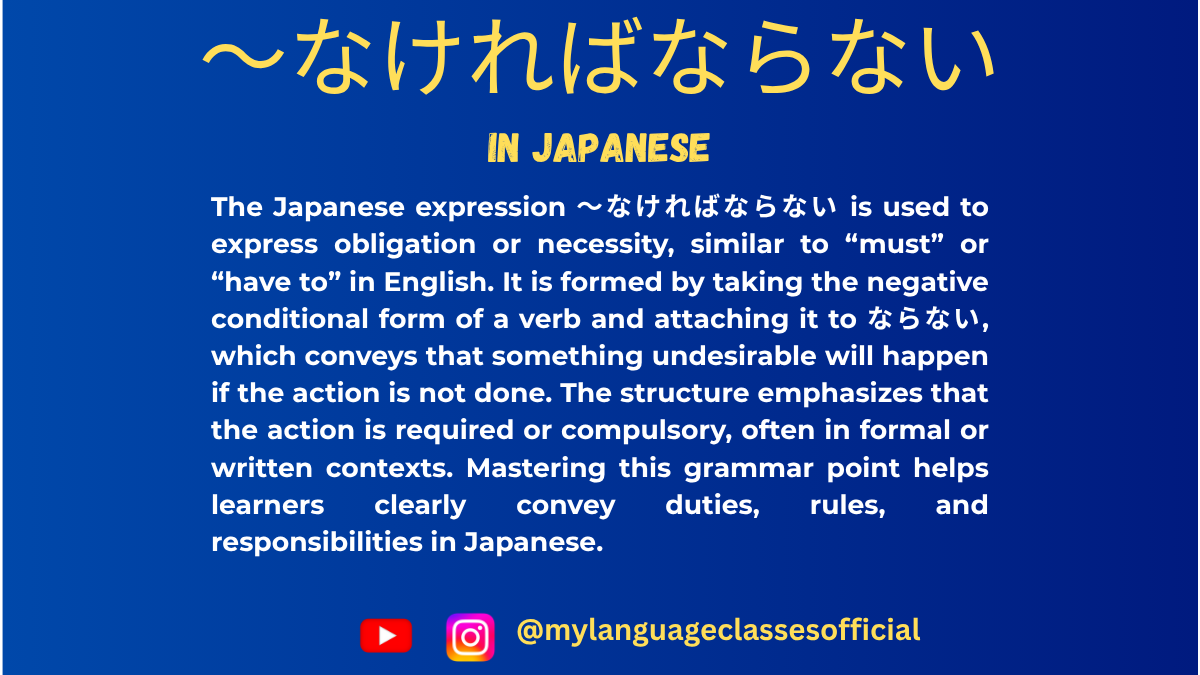
Understanding 〜なければならない in Japanese | My Language Classes
How to Use 〜なければならないin Japanese
The phrase 〜なければならない is a commonly used Japanese grammar structure that expresses obligation or necessity, similar to “must” or “have to” in English. It’s essential for learners to master this phrase because it is frequently used in both formal and casual settings.
Structure of 〜なければならない
- Verb in the Negative Form + なければならない
- Example: 行く → 行かなければならない
(iku → ikanakereba naranai)- Meaning: “I must go.”
- Example: 行く → 行かなければならない
- Conjugation Steps:
- Take the negative form of the verb (ない form).
- Replace ない with なければならない.
Variations of 〜なければならない
- 〜なければいけない
- Another common form with the same meaning.
- Slightly softer in tone.
- 〜なくてはならない
- Less commonly used in casual conversation but often appears in written or formal contexts.
- 〜なくてはいけない
- Similar to 〜なければいけない and used in formal or polite speech.
Situations Where 〜なければならない is Used
Here’s a list of situations where this grammar is appropriate:
1. Rules and Regulations
- Expressing obligations based on rules or laws.
- Example:
- 学校に行かなければならない。
(Gakkou ni ikanakereba naranai.)- Meaning: “I must go to school.”
- 学校に行かなければならない。
2. Work and Responsibilities
- Talking about duties or tasks that must be completed.
- Example:
- 仕事を終わらせなければならない。
(Shigoto o owarasena kereba naranai.)- Meaning: “I must finish the work.”
- 仕事を終わらせなければならない。
3. Social and Cultural Expectations
- Highlighting social norms or obligations.
- Example:
- 礼儀を守らなければならない。
(Reigi o mamorana kereba naranai.)- Meaning: “I must observe proper manners.”
- 礼儀を守らなければならない。
4. Personal Commitments
- Expressing personal resolutions or goals.
- Example:
- ダイエットのために運動しなければならない。
(Daietto no tame ni undou shinakereba naranai.)- Meaning: “I must exercise for my diet.”
- ダイエットのために運動しなければならない。
5. Health and Safety
- Discussing health-related necessities.
- Example:
- 健康のために野菜を食べなければならない。
(Kenkou no tame ni yasai o tabena kereba naranai.)- Meaning: “I must eat vegetables for my health.”
- 健康のために野菜を食べなければならない。
6. Moral or Ethical Obligations
- Talking about what is morally right.
- Example:
- 嘘をついてはいけないし、謝らなければならない。
(Uso o tsuite wa ikenai shi, ayamaranakereba naranai.)- Meaning: “I must not lie, and I must apologize.”
- 嘘をついてはいけないし、謝らなければならない。
7. Deadlines and Time-Sensitive Tasks
- When tasks need to be completed by a specific time.
- Example:
- 今週末までにレポートを提出しなければならない。
(Konshuumatsu made ni repooto o teishutsu shinakereba naranai.)- Meaning: “I must submit the report by this weekend.”
- 今週末までにレポートを提出しなければならない。
Key Points to Remember
- Formality:
- 〜なければならない is slightly more formal than 〜なければいけない. Use it in professional or formal writing.
- Alternative Expressions:
- In casual settings, people often shorten the phrase to 〜なきゃ or 〜なくちゃ.
- Example: 勉強しなきゃいけない (Benkyou shinakya ikenai) = “I must study.”
- In casual settings, people often shorten the phrase to 〜なきゃ or 〜なくちゃ.
- Cultural Context:
- Japanese culture values politeness and rules, so this structure is vital for expressing respect towards societal norms.
- Flexibility:
- While the grammar indicates obligation, tone and context can soften its intensity. For example, “You must” may sound harsh in English, but in Japanese, it’s often a gentle reminder or encouragement.
Practice Exercises
- Convert the following sentences into 〜なければならない form:
- 私は毎日運動する。
- 宿題をする。
- 早く起きる。
- Translate into Japanese:
- I must visit the doctor tomorrow.
- We have to clean the house by this evening.
- Imagine you are living in Japan. Write three sentences about what you “must” do in daily life using 〜なければならない.
Mastering 〜なければならない is crucial for understanding how to express obligations in Japanese effectively. Start using it in your conversations and writing to become more natural and fluent!
If you enjoyed this lesson, be sure to check out more posts like this on my blog at My Language Classes. Don’t forget to subscribe my YouTube channel and follow me on Instagram for the latest language learning tips and lessons. Leave a comment below to share your thoughts, or ask any questions you have about nouns.
Happy learning! 😊
- Verb in the Negative Form + なければならない
-
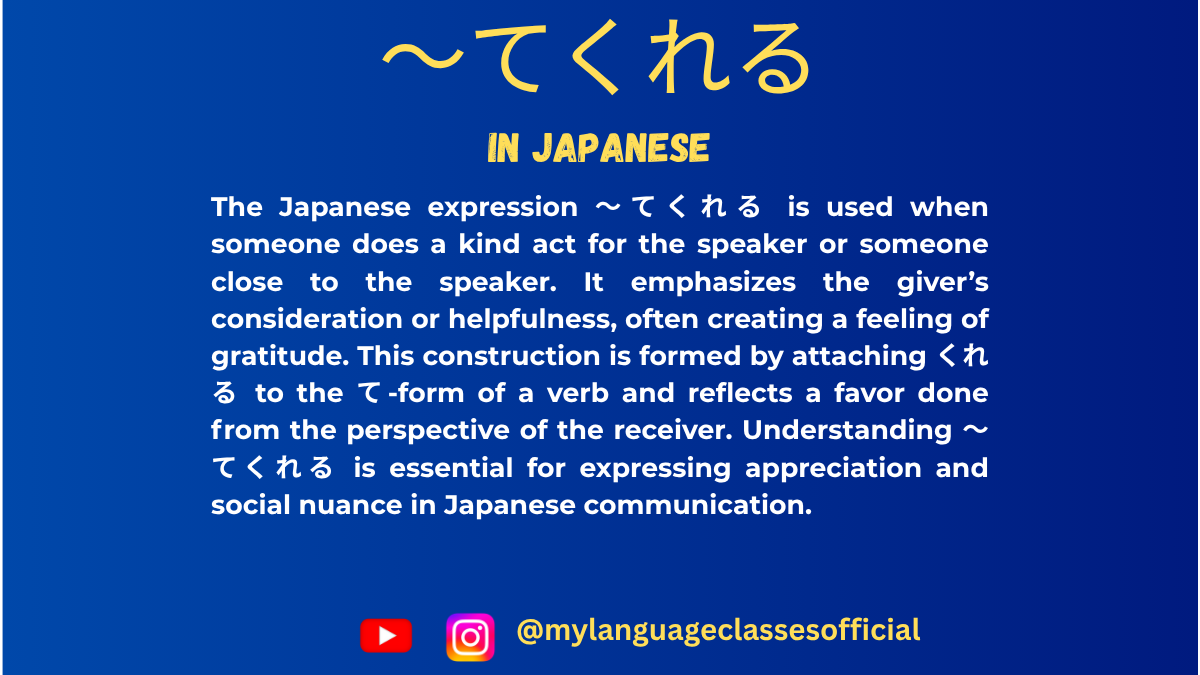
How to Use 〜てくれる | My Language Classes
Understanding “〜てくれる” in Japanese
The Japanese expression 〜てくれる is a key grammatical structure used to describe actions done for the speaker’s benefit or someone close to them. It conveys gratitude and appreciation towards the doer. Let’s explore its usage in various contexts and provide a list of situations where “〜てくれる” is used.
What is 〜てくれる?
“〜てくれる” is derived from the verb くれる, which means “to give.” When attached to the て-form of a verb, it expresses that someone performs an action for the speaker (or someone in the speaker’s inner circle). It implies a sense of appreciation and goodwill.
- Structure:
[Person] が [Verb (て-form)] くれる
(Someone does something for me or someone in my group.) - Example:
- 友達が宿題を手伝ってくれた。
(Tomodachi ga shukudai o tetsudatte kureta.)
→ “My friend helped me with my homework.” - 先生が日本語を教えてくれました。
(Sensei ga Nihongo o oshiete kuremashita.)
→ “The teacher kindly taught me Japanese.”
- 友達が宿題を手伝ってくれた。
Situations Where 〜てくれる is Used
1. When Someone Helps You
Used when someone provides assistance that benefits the speaker.
- Example:
- 兄が荷物を運んでくれた。 (Ani ga nimotsu o hakonde kureta.)
→ “My older brother carried my luggage for me.”
- 兄が荷物を運んでくれた。 (Ani ga nimotsu o hakonde kureta.)
2. When Someone Gives You Something
Used when someone gives you an object (related to くれる itself).
- Example:
- 友達がプレゼントを買ってくれた。 (Tomodachi ga purezento o katte kureta.)
→ “My friend bought me a present.”
- 友達がプレゼントを買ってくれた。 (Tomodachi ga purezento o katte kureta.)
3. When Someone Does a Favor for You
Used when someone voluntarily does something kind.
- Example:
- 彼が傘を貸してくれた。 (Kare ga kasa o kashite kureta.)
→ “He lent me an umbrella.”
- 彼が傘を貸してくれた。 (Kare ga kasa o kashite kureta.)
4. When Someone Teaches or Instructs You
Used when someone imparts knowledge or skills.
- Example:
- 先生が漢字の書き方を教えてくれた。 (Sensei ga kanji no kakikata o oshiete kureta.)
→ “The teacher taught me how to write kanji.”
- 先生が漢字の書き方を教えてくれた。 (Sensei ga kanji no kakikata o oshiete kureta.)
5. When Someone Listens to You
Used when someone listens or gives attention to you.
- Example:
- 友達が悩みを聞いてくれた。 (Tomodachi ga nayami o kiite kureta.)
→ “My friend listened to my worries.”
- 友達が悩みを聞いてくれた。 (Tomodachi ga nayami o kiite kureta.)
6. When Someone Accompanies You
Used when someone goes with you somewhere.
- Example:
- 母が病院まで一緒に行ってくれた。 (Haha ga byouin made issho ni itte kureta.)
→ “My mother went to the hospital with me.”
- 母が病院まで一緒に行ってくれた。 (Haha ga byouin made issho ni itte kureta.)
7. When Someone Encourages or Supports You
Used when someone gives encouragement.
- Example:
- 彼が試験の前に励ましてくれた。 (Kare ga shiken no mae ni hagemashite kureta.)
→ “He encouraged me before the exam.”
- 彼が試験の前に励ましてくれた。 (Kare ga shiken no mae ni hagemashite kureta.)
8. When Someone Waits for You
Used when someone waits patiently for you.
- Example:
- 友達が駅で待ってくれた。 (Tomodachi ga eki de matte kureta.)
→ “My friend waited for me at the station.”
- 友達が駅で待ってくれた。 (Tomodachi ga eki de matte kureta.)
9. When Someone Fixes or Repairs Something for You
Used when someone fixes something for your benefit.
- Example:
- 父が自転車を直してくれた。 (Chichi ga jitensha o naoshite kureta.)
→ “My father fixed my bicycle.”
- 父が自転車を直してくれた。 (Chichi ga jitensha o naoshite kureta.)
10. When Someone Invites You or Gives You a Treat
Used when someone invites or pays for you.
- Example:
- 彼がコーヒーをおごってくれた。 (Kare ga koohii o ogotte kureta.)
→ “He treated me to coffee.”
- 彼がコーヒーをおごってくれた。 (Kare ga koohii o ogotte kureta.)
Notes on Usage
- Subject Consideration:
- The giver of the action is the grammatical subject, not the receiver.
- Example:
- 彼がケーキを作ってくれた。 (He made a cake for me.)
- 私にケーキを作ってくれた is unnatural (omit 私に).
- Politeness Levels:
- Casual: 〜てくれる
- Polite: 〜てくれます
- Past polite: 〜てくれました
- Not Used for Superior-to-Subordinate Actions:
- You cannot use 〜てくれる when a subordinate (like a junior worker) does something for a superior (like a boss). Instead, use 〜てくださいました (keigo).
Conclusion
The expression 〜てくれる is an essential part of Japanese communication, showing gratitude when someone does something beneficial for the speaker. By understanding the different contexts in which it is used, learners can express appreciation naturally and appropriately in Japanese conversations.
Do you have any questions about 〜てくれる? Let me know in the comments! 😊
If you enjoyed this lesson, be sure to check out more posts like this on my blog at My Language Classes. Don’t forget to subscribe my YouTube channel and follow me on Instagram for the latest language learning tips and lessons. Leave a comment below to share your thoughts, or ask any questions you have about nouns.
Happy learning! 😊
- Structure:
-

How to Use 〜てもらう | My Language Classes
The Japanese Grammar 〜てもらう
The Japanese grammar pattern 〜てもらう is an essential structure used to express receiving a favor from someone. It emphasizes that someone is doing something beneficial for the speaker or a third party. Understanding this grammar is crucial for natural and polite Japanese communication.
This post will explain 〜てもらう in various situations, provide example sentences, and list common contexts where it is used.
Structure of 〜てもらう
The pattern follows this structure:
Person A (receiver) + は/が + Person B (doer) + に + Verb in 〜て form + もらう
- A is the person who benefits from the action.
- B is the person performing the action for A.
- The verb is conjugated into the て-form and followed by もらう (to receive).
Example:
- 私は先生に日本語を教えてもらいました。
(I had my teacher teach me Japanese.)
Difference Between 〜てもらう and 〜てあげる
- 〜てもらう: Focuses on the receiver of the favor.
- 〜てあげる: Focuses on the giver of the favor.
Example:
- 私は先生に日本語を教えてもらいました。 (I received Japanese lessons from my teacher.)
- 私は先生に日本語を教えてあげました。 (I taught Japanese to my teacher.)
Various Situations Where 〜てもらう Is Used
1. Receiving Help
When someone helps you with a task or does something for your benefit.
Example:
- 私は彼氏に財実を送ってもらいました。
(I had my boyfriend send my wallet.)
2. Receiving Permission
Used when asking for permission to do something.
Example:
- 先生にはやく帰らせてもらいました。
(I got permission from my teacher to leave early.)
3. Receiving a Favor Indirectly
You receive a favor, but a third party performs the action.
Example:
- 母は先生にむすこの学校の事を説明してもらいました。
(My mother had the teacher explain about the school to her.)
4. Making Polite Requests
When requesting someone to do something politely.
Example:
- この文章を正しく直してもらえますか。
(Could you please correct this text for me?)
5. Receiving Information
When someone shares knowledge or guidance.
Example:
- 先生にいろいろな情報を教えてもらいました。
(I received a lot of information from my teacher.)
6. Asking for Medical Assistance
Used when getting treatment or medical help from someone.
Example:
- 医者に病治をしてもらいました。
(I got treated by the doctor.)
7. Receiving a Physical Object
Used when someone gives you something.
Example:
- 友人に好きな本を買ってもらいました。
(My friend bought me a book I like.)
8. Receiving Guidance or Instructions
Used when someone teaches you or gives instructions.
Example:
- 先生に作文の書き方を教えてもらいました。
(I had my teacher teach me how to write essays.)
Summary of Situations Where 〜てもらう Is Used
Here’s a quick reference list:
- Receiving help (task-related support)
- Receiving permission
- Receiving a favor indirectly
- Making polite requests
- Receiving information or knowledge
- Asking for medical assistance
- Receiving a physical object
- Receiving guidance or instructions
Conclusion
〜てもらう is a crucial grammar point in Japanese, allowing you to express receiving favors, help, or benefits from others. Mastering this structure enhances your ability to communicate politely and effectively in various situations. Practice using it in conversations to improve fluency and comprehension!
If you enjoyed this lesson, be sure to check out more posts like this on my blog at My Language Classes. Don’t forget to subscribe my YouTube channel and follow me on Instagram for the latest language learning tips and lessons. Leave a comment below to share your thoughts, or ask any questions you have about nouns.
Happy learning! 😊
-
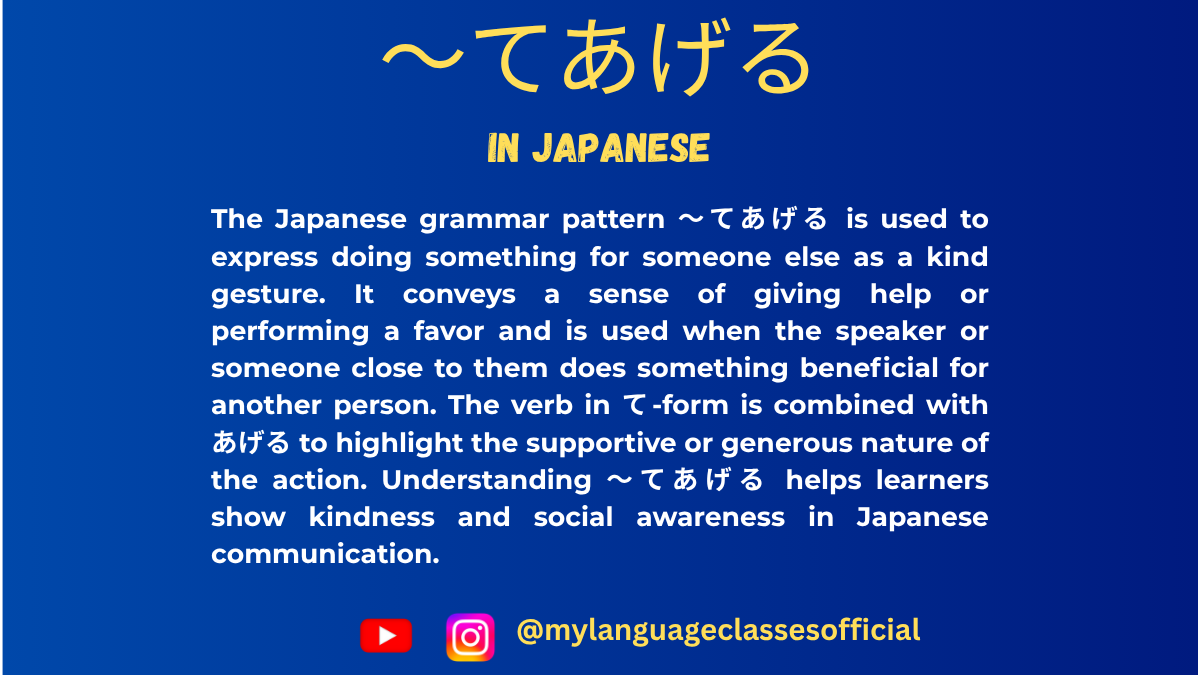
How to Use 〜てあげる | My Language Classes
〜てあげる: To Give (an Action) in Japanese
When learning Japanese, you will often encounter the phrase 〜てあげる (te ageru), which means “to give (an action).” This phrase is used when the speaker or someone performs a beneficial action for another person. The nuance of 〜てあげる is that the action is done out of kindness or generosity.
How to Use 〜てあげる
The structure is simple:
[Person] は [Recipient] に [Action in 〜て-form] + あげる
Example:
- わたしは ともだち に 本を 貸してあげました。
(Watashi wa tomodachi ni hon o kashite agemashita.)
→ I lent a book to my friend (as a favor).
Different Forms of 〜てあげる
The verb あげる can be conjugated into different forms to match the politeness level:
Form Usage 〜てあげる Casual/plain form 〜てあげます Polite form 〜てあげて Te-form for requests 〜てあげない Negative form (not doing the action) 〜てあげなかった Past negative form Situations Where 〜てあげる Is Used
1. Doing Something Nice for Someone Else
- わたしは ちょうとせんせい に にもつを 持ってあげました。
(Watashi wa chouto sensei ni nimotsu o motte agemashita.)
→ I carried the teacher’s luggage for them.
2. Helping Someone
- おとうさんは ぼくに 自転車の修理を してあげた。
(Otousan wa boku ni jitensha no shuuri o shite ageta.)
→ Dad fixed my bicycle for me.
3. Giving Advice or Instruction
- わたしは ともだち に 日本語 を 教えてあげる。
(Watashi wa tomodachi ni nihongo o oshiete ageru.)
→ I will teach my friend Japanese.
4. Buying Something for Someone
- おかあさんは いもうと に 花を 買ってあげました。
(Okaasan wa imouto ni hana o katte agemashita.)
→ Mom bought flowers for my little sister.
5. Making a Favorable Gesture
- 私は 友達 に コーヒーを 作ってあげました。
(Watashi wa tomodachi ni koohii o tsukutte agemashita.)
→ I made coffee for my friend.
6. Expressing Kindness in a Relationship
- けんたろうは かのじょに マッサージを かいてあげた。
(Kentaro wa kanojo ni massaaji o kaite ageta.)
→ Kentaro gave his girlfriend a massage.
7. Helping Children or Animals
- おねえさんは 犬 に 食べ物 を あげてあげた。
(Oneesan wa inu ni tabemono o agete ageta.)
→ The older sister gave food to the dog.
Things to Remember About 〜てあげる
- Used when the action is beneficial: You should only use 〜てあげる when the action is helpful or kind.
- Do not use for superiors: Avoid using 〜てあげる when speaking about actions for a superior (e.g., boss, teacher) as it may sound rude. Instead, use 〜てさしあげる.
- Casual tone: This phrase is often used in informal or everyday conversations rather than in formal writing.
Summary Table: When to Use 〜てあげる
Situation Example Helping a friend はさみを 買ってあげた。 (Bought scissors for them.) Teaching someone えいご を 教えてあげる。 (Teach English to them.) Doing a favor 部屋を 掃除してあげる。 (Clean the room for them.) Helping animals 犬 に 飯 を あげてあげる。 (Give food to a dog.) By mastering 〜てあげる, you can express kindness and generosity in Japanese naturally! Practice using it in real conversations to make your speech sound more fluent and native-like.
Do you have any questions about 〜てあげる? Let me know in the comments!
If you enjoyed this lesson, be sure to check out more posts like this on my blog at My Language Classes. Don’t forget to subscribe my YouTube channel and follow me on Instagram for the latest language learning tips and lessons. Leave a comment below to share your thoughts, or ask any questions you have about nouns.
Happy learning! 😊
- わたしは ともだち に 本を 貸してあげました。
-
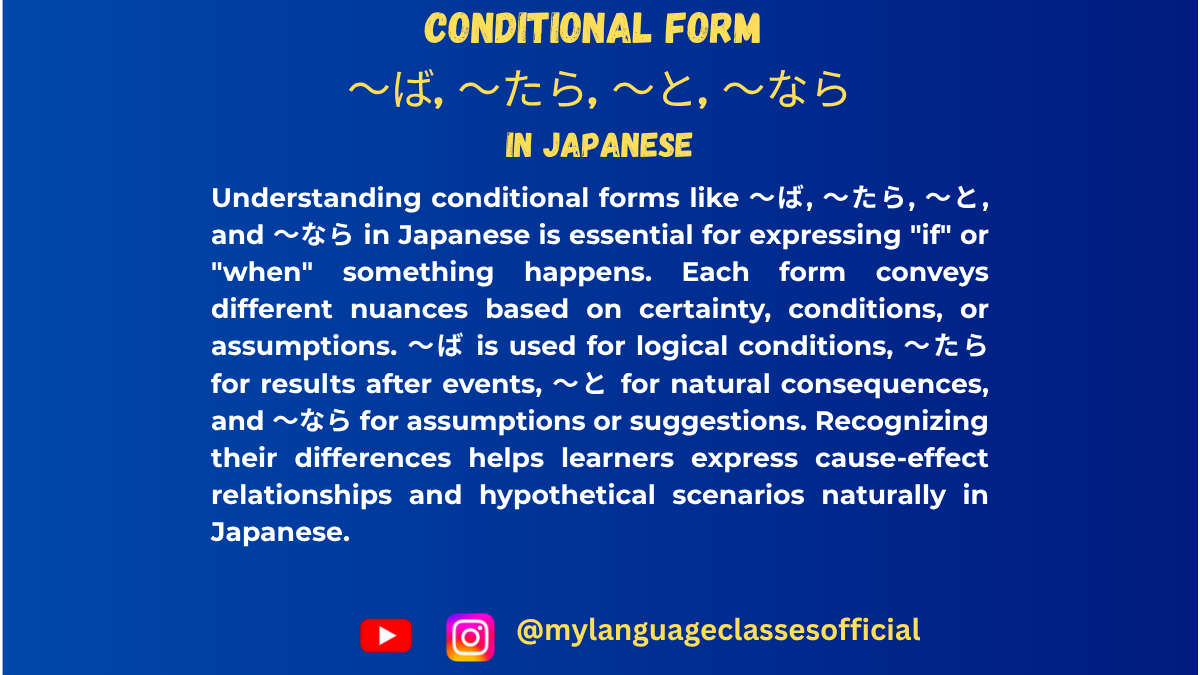
All Japanese Conditionals 〜ば, 〜たら, 〜と, 〜ならExplained | My Language Classes
Japanese Conditional Forms: 〜ば, 〜たら, 〜と, 〜なら Explained
In Japanese, conditional and hypothetical sentences are commonly expressed using four key grammatical structures: 〜ば, 〜たら, 〜と, and 〜なら. Each has unique nuances and appropriate usage contexts. In this article, we will explore each form, compare them, and provide a list of situations where they are used.
1. 〜ば (Ba-form)
Usage:
- Expresses general conditions and hypothetical situations.
- Often used in formal speech and writing.
- Cannot be used for past events.
- Cannot be used with volitional expressions (e.g., requests, invitations).
Formation:
Verb Type Formation Ichidan (る-verbs) Drop る + れば (e.g., 食べる → 食べれば) Godan (う-verbs) Change last う-row syllable to え-row + ば (e.g., 行く → 行けば) Adjectives (い-adj.) Drop い + ければ (e.g., 安い → 安ければ) Nouns/な-adjectives + ならば (e.g., 便利ならば) Examples:
- 早く行けば、電車に間に合いますよ。(If you go early, you will catch the train.)
- お金があれば、旅行したいです。(If I have money, I want to travel.)
- 静かであれば、勉強しやすいです。(If it is quiet, it is easy to study.)
2. 〜たら (Tara-form)
Usage:
- Used for general conditions, past conditions, and hypothetical situations.
- Can be used in past, present, or future contexts.
- Can be used with volitional expressions (e.g., requests, invitations).
Formation:
Word Type Formation Verbs (Past た-form + ら) 飲む → 飲んだら い-adjectives 楽しい → 楽しかったら な-adjectives / Nouns 簡単だ → 簡単だったら Examples:
- 雨が降ったら、家にいます。(If it rains, I will stay home.)
- お金があったら、旅行に行きたいです。(If I had money, I would travel.)
- 暇だったら、手伝ってください。(If you are free, please help.)
3. 〜と (To-form)
Usage:
- Expresses natural consequences, habitual results, and general truths.
- Does not express personal volition or future uncertainty.
- Common in proverbs and scientific facts.
Formation:
Word Type Formation Verbs (Dictionary form + と) 行く → 行くと い-adjectives 高い → 高いと な-adjectives / Nouns 便利だ → 便利だと Examples:
- 春になると、桜が咲きます。(When spring comes, cherry blossoms bloom.)
- このボタンを押すと、ドアが開きます。(If you press this button, the door will open.)
- 夜になると、気温が下がります。(When it becomes night, the temperature drops.)
4. 〜なら (Nara-form)
Usage:
- Used for assumptions, recommendations, and contextual conditions.
- Often used in conversations.
- Used when giving advice or referring to prior information.
Formation:
Word Type Formation Verbs (Dictionary form + なら) 行く → 行くなら い-adjectives 面白い → 面白いなら な-adjectives / Nouns 簡単だ → 簡単なら Examples:
- 日本に行くなら、京都を訪れるべきです。(If you go to Japan, you should visit Kyoto.)
- お金がないなら、アルバイトをしたほうがいい。(If you don’t have money, you should get a part-time job.)
- 映画を見るなら、ポップコーンを買いましょう。(If we’re watching a movie, let’s buy popcorn.)
5. Comparison Table: 〜ば vs. 〜たら vs. 〜と vs. 〜なら
Condition Type 〜ば 〜たら 〜と 〜なら General Conditions ✅ ✅ ✅ ✅ Hypothetical Situations ✅ ✅ ❌ ✅ Past Situations ❌ ✅ ❌ ✅ Natural Consequences ❌ ❌ ✅ ❌ Volitional Expressions ❌ ✅ ❌ ✅ Recommendations/Advice ❌ ❌ ❌ ✅
6. Situations Where They Are Used
Situation Example Best Form If it rains, I will stay home. 雨が降ったら、家にいます。 〜たら If you push this button, the door will open. このボタンを押すと、ドアが開きます。 〜と If I had money, I would travel. お金があれば、旅行したい。 〜ば If you are free, please help me. 暇だったら、手伝ってください。 〜たら If you go to Japan, you should visit Kyoto. 日本に行くなら、京都を訪れるべきです。 〜なら If you don’t study, you will fail the exam. 勉強しないと、試験に落ちる。 〜と
Conclusion
Each of these conditional forms—〜ば, 〜たら, 〜と, and 〜なら—has its specific nuances and contexts. By mastering these distinctions, learners can express conditional and hypothetical ideas naturally and accurately in Japanese. Understanding when to use each structure will significantly improve fluency and comprehension.
If you enjoyed this lesson, be sure to check out more posts like this on my blog at My Language Classes. Don’t forget to subscribe my YouTube channel and follow me on Instagram for the latest language learning tips and lessons. Leave a comment below to share your thoughts, or ask any questions you have about nouns.
Happy learning! 😊
-
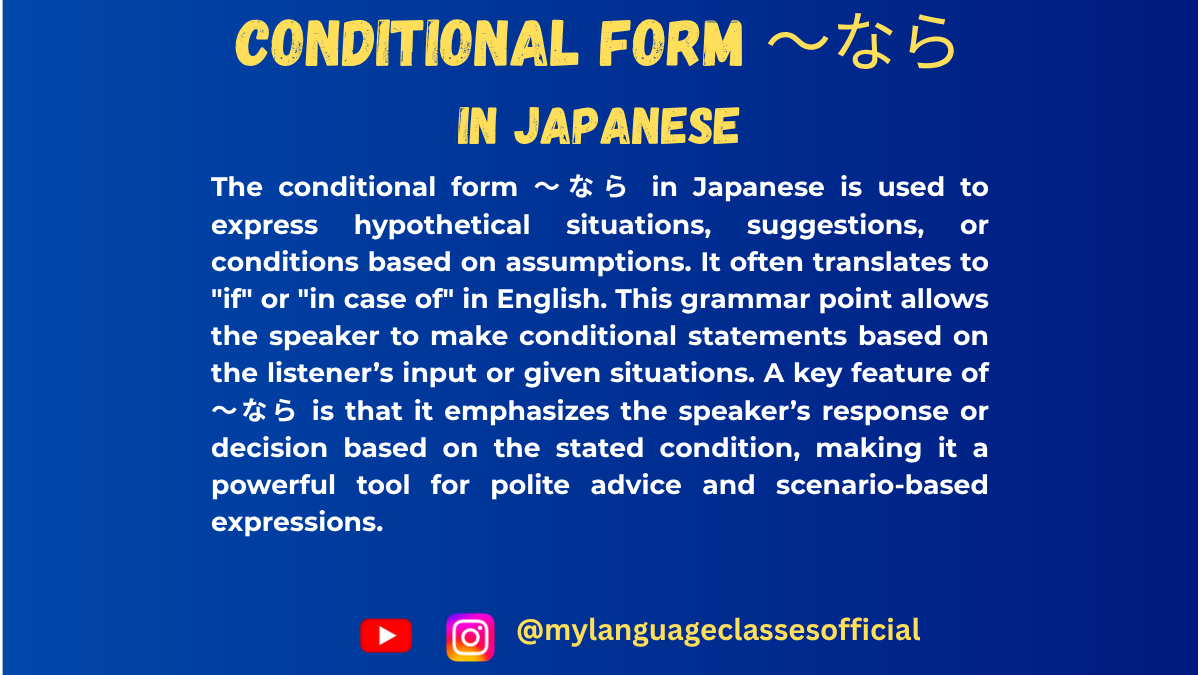
Using 〜なら for hypothetical situations | My Language Classes
〜なら: Expressing “If” or “As for” in Japanese
In Japanese, 〜なら is a versatile grammar structure often used to express conditionality (“if”) or to provide contextual emphasis (“as for”). This blog post will explore its usage in various contexts and provide a comprehensive list of situations where 〜なら is applicable.
What is 〜なら?
The particle なら is derived from the verb 成る (なる), which means “to become.” In grammar, it functions as a conditional marker or a topic-related particle depending on the context. It is commonly attached to the plain form of verbs, nouns, or adjectives.
Usage of 〜なら
1. Conditional “If”
- Meaning: Expresses a hypothetical or conditional situation.
- Structure:
Clause A (plain form) + なら, Clause B
Clause B often represents the speaker’s judgment, advice, or consequence.
Examples:
- 日本に行くなら、富士山を見たほうがいいですよ。
(Nihon ni iku nara, Fujisan o mita hō ga ii desu yo.)
If you’re going to Japan, you should see Mt. Fuji. - 雨が降るなら、外出しないほうがいいです。
(Ame ga furu nara, gaishutsu shinai hō ga ii desu.)
If it rains, you shouldn’t go out.
2. Topic-Based “As for”
- Meaning: Indicates that a specific topic is being addressed in response to a preceding statement or question.
- Structure:
Noun + なら
Examples:
- 映画なら、コメディが一番好きです。
(Eiga nara, komedi ga ichiban suki desu.)
As for movies, I like comedies the best. - この本なら、もう読んだことがあります。
(Kono hon nara, mō yonda koto ga arimasu.)
As for this book, I’ve already read it.
3. Contrasting Ideas
- Meaning: Suggests a contrast between two different ideas or topics.
- Structure:
Noun/Adjective/Verb + なら
Examples:
- 英語なら話せますが、フランス語は話せません。
(Eigo nara hanasemasu ga, Furansugo wa hanasemasen.)
If it’s English, I can speak it, but I can’t speak French. - 安いなら買いますが、高いなら買いません。
(Yasui nara kaimasu ga, takai nara kaimasen.)
If it’s cheap, I’ll buy it, but if it’s expensive, I won’t.
4. Hypothetical Suggestions
- Meaning: Used when giving suggestions or advice based on hypothetical conditions.
- Structure:
Clause + なら
Examples:
- 東京に行くなら、スカイツリーを訪れるべきです。
(Tōkyō ni iku nara, Sukaitsurī o otozureru beki desu.)
If you’re visiting Tokyo, you should check out the Skytree. - 勉強するなら、早めに始めたほうがいいですよ。
(Benkyō suru nara, hayame ni hajimeta hō ga ii desu yo.)
If you’re going to study, it’s better to start early.
5. Clarifications or Conditions
- Meaning: Used when responding to a condition or clarifying information.
- Structure:
Noun + なら
Examples:
- 山田さんなら、もう帰りましたよ。
(Yamada-san nara, mō kaerimashita yo.)
If you’re talking about Yamada-san, he’s already gone home. - 駅なら、この道をまっすぐ行けば着きます。
(Eki nara, kono michi o massugu ikeba tsukimasu.)
If you mean the station, go straight down this road.
When to Use 〜なら?
Here is a quick checklist of situations where 〜なら is appropriate:
- Making a Hypothetical Conditional Statement:
“If you’re going to X, then Y.” - Responding to Questions or Comments with Context:
“As for X, Y applies.” - Contrasting Two Scenarios or Topics:
“If X is true, Y. But if not, Z.” - Providing Advice Based on Hypothetical Situations:
“If you’re considering X, then Y is a good idea.” - Clarifying or Confirming a Specific Topic:
“If you’re talking about X, then Y.”
Tips for Using 〜なら
- Be Contextual: 〜なら thrives on context. Make sure the listener understands the implied condition or topic.
- Be Specific: Use it to address clear contrasts or hypothetical situations, avoiding vague statements.
- Practice Intonation: When using 〜なら in spoken Japanese, emphasize the conditional tone to make your intent clear.
By mastering 〜なら, you’ll find yourself able to express conditions, offer advice, and clarify topics more effectively in Japanese. Practice by creating your own sentences in real-life scenarios!
If you enjoyed this lesson, be sure to check out more posts like this on my blog at My Language Classes. Don’t forget to subscribe my YouTube channel and follow me on Instagram for the latest language learning tips and lessons. Leave a comment below to share your thoughts, or ask any questions you have about nouns.
Happy learning! 😊
-
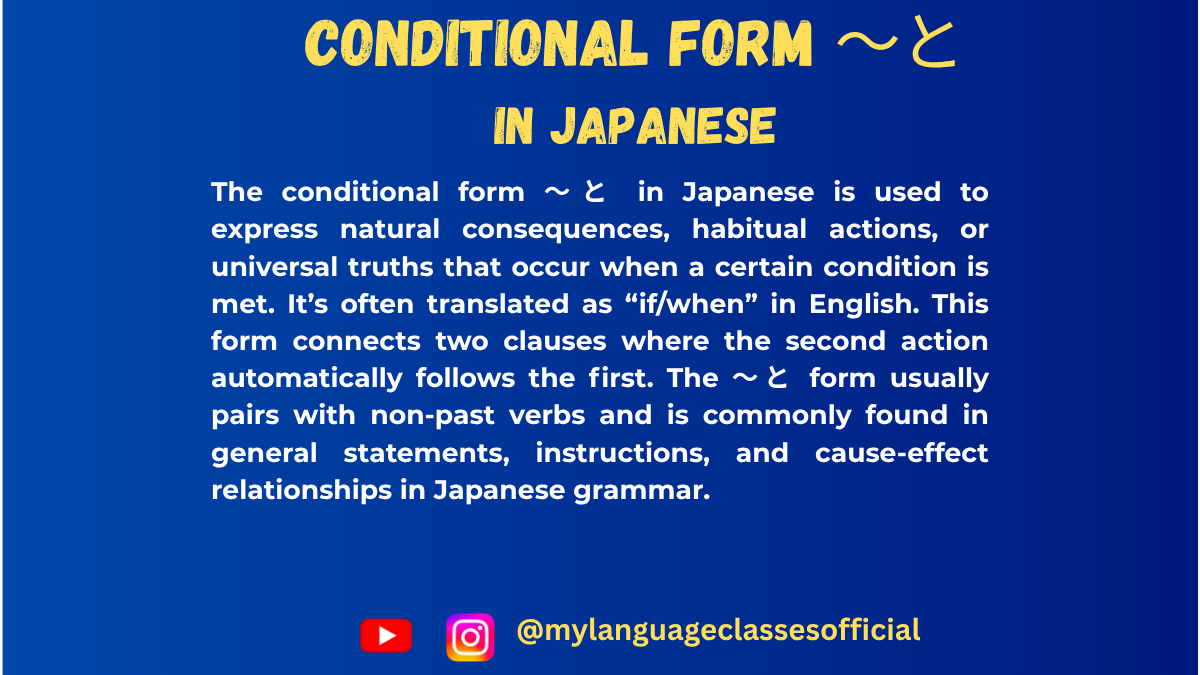
Using 〜と for Natural Consequence | My Language Classes
Expressing a Natural Consequence in Japanese: 〜と
In Japanese, the particle 〜と has a variety of usages, but it is commonly employed to express natural consequences, conditions, or outcomes. Understanding 〜と is essential for mastering conditional sentences and making logical connections between actions or states.
This blog post will explore the various situations where 〜と is used, providing detailed explanations and examples to help you grasp its nuances.
Primary Uses of 〜と
- Expressing a Natural or Inevitable Consequence When 〜と is used, it implies that the result is a natural or automatic outcome of the preceding action or condition. This is particularly common in scientific or logical statements.Structure:
- Clause A と Clause B
(When Clause A happens, Clause B naturally follows.)
- ボタンを押すと、ドアが開きます。
(When you press the button, the door opens.) - 冬になると、雪が降ります。
(When it becomes winter, it snows.)
- Clause A と Clause B
- Habitual Actions or Repeated Outcomes
〜と can describe a habitual action or repeated phenomenon triggered by a condition.Examples:- 朝起きると、コーヒーを飲みます。
(When I wake up in the morning, I drink coffee.) - 毎回この歌を聞くと、昔を思い出します。
(Every time I hear this song, I remember the past.)
- 朝起きると、コーヒーを飲みます。
- Discoveries or Unexpected Realizations
〜と is used to describe a situation where the speaker discovers something upon performing an action.Examples:- ドアを開けると、猫がいました。
(When I opened the door, there was a cat.) - 山の頂上に着くと、美しい景色が広がっていました。
(When I reached the mountain summit, a beautiful view spread out before me.)
- ドアを開けると、猫がいました。
- Warnings and Hypothetical Negative Outcomes
〜と can express a warning or a negative consequence if a certain action is performed.Examples:- 急がないと、電車に乗り遅れますよ。
(If you don’t hurry, you’ll miss the train.) - そんなことをすると、後で後悔しますよ。
(If you do such a thing, you’ll regret it later.)
- 急がないと、電車に乗り遅れますよ。
- Instructions or Rules in Conditional Situations
In formal contexts, 〜と is used to convey instructions, rules, or expected outcomes.Examples:- お金を入れると、商品が出てきます。
(When you insert money, the product comes out.) - このボタンを押すと、エンジンがスタートします。
(When you press this button, the engine starts.)
- お金を入れると、商品が出てきます。
Key Differences Between 〜と and Other Conditional Particles
- 〜と vs 〜ば
While both can describe conditions, 〜ば focuses more on hypothetical or general conditions, whereas 〜と emphasizes a natural or inevitable result.
Example:- 〜と: 雨が降ると、道が濡れます。
(When it rains, the roads get wet.) - 〜ば: 雨が降れば、試合は中止になるでしょう。
(If it rains, the match will likely be canceled.)
- 〜と: 雨が降ると、道が濡れます。
- 〜と vs 〜たら
〜たら is often used for one-time conditions or events and can handle past-tense conditions, unlike 〜と.
Example:- 〜と: 春になると、桜が咲きます。
(When it becomes spring, cherry blossoms bloom.) - 〜たら: 春になったら、旅行に行きたいです。
(When it becomes spring, I want to travel.)
- 〜と: 春になると、桜が咲きます。
List of Situations Where 〜と Is Used
- Natural or inevitable consequences.
- Habitual actions or consistent outcomes.
- Discoveries or unexpected realizations.
- Warnings or hypothetical negative outcomes.
- Instructions, rules, or predictable results in formal contexts.
Points to Remember About 〜と
- Non-Intentional Clause B:
The second clause (Clause B) must describe something out of the speaker’s control, such as a fact, habitual action, or natural consequence. - No Past-Tense Clause A:
The first clause (Clause A) cannot be in the past tense.
Example:- Incorrect: 彼が来たと、部屋が明るくなった。
- Correct: 彼が来ると、部屋が明るくなった。
(When he comes, the room becomes brighter.)
- Clear Cause-and-Effect Relationship:
There must be a logical and automatic relationship between Clause A and Clause B.
Mastering 〜と will enhance your ability to create logical, fluent sentences in Japanese. By understanding its nuances and contexts, you’ll find it easier to express cause-and-effect relationships and describe habitual or natural outcomes in daily conversation and writing.
If you enjoyed this lesson, be sure to check out more posts like this on my blog at My Language Classes. Don’t forget to subscribe my YouTube channel and follow me on Instagram for the latest language learning tips and lessons. Leave a comment below to share your thoughts, or ask any questions you have about nouns.
Happy learning! 😊
- Expressing a Natural or Inevitable Consequence When 〜と is used, it implies that the result is a natural or automatic outcome of the preceding action or condition. This is particularly common in scientific or logical statements.Structure:
-

Understanding 〜たら (If/When) | My Language Classes
Understanding the Conditional “If” or “When” in Japanese
Japanese is a beautifully nuanced language, and understanding its conditional expressions is essential to mastering its grammar. Among these, 〜たら is one of the most versatile and commonly used forms to express conditionality. While it often translates to “if” or “when” in English, its usage varies depending on context. In this blog post, we’ll dive into everything you need to know about 〜たら, including its formation, usage, and specific examples for different scenarios.
What is 〜たら?
The term 〜たら comes from the た-form of verbs, adjectives, or copulas, combined with the particle ら. This construction is used to describe a condition that must be met for the second clause to occur. Its meaning can vary depending on the time and certainty implied in the context.
Formation:
- Verbs:
Base verb (た-form) + ら
Example: 食べる (to eat) → 食べたら (if/when [you] eat) - Adjectives (い-adjectives):
Drop the い, add かった, then add ら.
Example: 楽しい (fun) → 楽しかったら (if/when [it’s] fun) - Adjectives (な-adjectives) & Nouns:
Add だったら after the base word.
Example: 静か (quiet) → 静かだったら (if/when [it’s] quiet)
学生 (student) → 学生だったら (if/when [you’re] a student)
When to Use 〜たら
〜たら is used in a variety of scenarios, and understanding the context is key to choosing the right conditional expression in Japanese. Below are the primary uses of 〜たら with examples.
1. Hypothetical Conditions (“If”)
When describing a situation that may or may not happen, 〜たら acts like “if” in English.
- Example:
雨が降ったら、家にいます。
(If it rains, I’ll stay home.)
2. Temporal Conditions (“When”)
〜たら can indicate “when” for an action that will happen after the condition is met.
- Example:
宿題が終わったら、遊びに行きましょう。
(When you finish your homework, let’s go play.)
3. Unrealistic or Imaginary Conditions
When discussing hypothetical scenarios that are unlikely or purely imaginary, 〜たら is the go-to form.
- Example:
お金持ちだったら、世界中を旅行したい。
(If I were rich, I would like to travel the world.)
4. Unexpected Results
In some cases, the action in the second clause is surprising or contrary to what was expected from the condition in the first clause.
- Example:
ドアを開けたら、猫がいました。
(When I opened the door, there was a cat.)
[Note: The speaker didn’t expect a cat to be there.]
5. Past Actions Followed by Realization
〜たら is also used when an action is completed, and the speaker realizes or learns something new afterward.
- Example:
その映画を見たら、泣いてしまった。
(When I watched that movie, I ended up crying.)
6. Conditional Advice or Suggestions
To offer advice or make suggestions contingent on a condition.
- Example:
疲れたら、休んだほうがいいですよ。
(If you’re tired, you should take a rest.)
List of Situations Where 〜たら is Used
Here’s a concise list of common situations where 〜たら appears:
- Hypothetical conditions: Speculating about what might happen.
- Temporal conditions: Actions that occur sequentially.
- Unrealistic conditions: Hypothetical scenarios (e.g., dreams or fantasies).
- Surprising or unexpected outcomes: Actions that yield unforeseen results.
- Post-event realization: Discoveries made after completing an action.
- Giving advice or suggestions: Contingent recommendations.
- Plans based on conditions: Situations where future actions depend on prior conditions.
How is 〜たら Different from Other Conditionals?
Japanese has several conditional forms, such as と, ば, and なら, which can sometimes overlap in meaning. Here’s how 〜たら compares:
- 〜たら is versatile and works for past, present, and future conditions, as well as hypothetical and temporal situations.
- と emphasizes natural consequences or inevitable results (e.g., “If you press this button, the door will open”).
- ば is more formal and focuses on hypothetical or logical outcomes.
- なら introduces a topic or focuses on conditions assumed to be true (e.g., “If it’s about Tokyo, I know a lot”).
Practice Makes Perfect!
To truly master 〜たら, practice creating sentences for various scenarios. Start with simple sentences like:
- 雨が降ったら、どうしますか?
(If it rains, what will you do?)
Then, challenge yourself with complex structures:
- この本を読んだら、新しい考え方が学べると思います。
(I think if you read this book, you’ll learn a new way of thinking.)
Conclusion
Understanding 〜たら is essential for fluency in Japanese. Its flexibility allows it to cover a range of situations, from hypothetical scenarios to real-life sequential actions. By practicing its usage and comparing it to other conditionals, you’ll be able to express yourself naturally and accurately in Japanese. Remember, context is everything, so keep practicing, and soon enough, using 〜たら will feel as natural as saying “if” or “when” in English!
If you enjoyed this lesson, be sure to check out more posts like this on my blog at My Language Classes. Don’t forget to subscribe my YouTube channel and follow me on Instagram for the latest language learning tips and lessons. Leave a comment below to share your thoughts, or ask any questions you have about nouns.
Happy learning! 😊
- Verbs:

